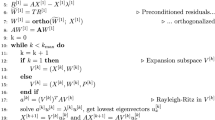Abstract
A novel orthogonalization-free method together with two specific algorithms is proposed to address extreme eigenvalue problems. On top of gradient-based algorithms, the proposed algorithms modify the multicolumn gradient such that earlier columns are decoupled from later ones. Locally, both algorithms converge linearly with convergence rates depending on eigengaps. Momentum acceleration, exact linesearch, and column locking are incorporated to accelerate algorithms and reduce their computational costs. We demonstrate the efficiency of both algorithms on random matrices with different spectrum distributions and matrices from computational chemistry.



Similar content being viewed by others
Data Availability
Enquiries about data availability should be directed to the authors.
References
Banerjee, A.S., Lin, L., Hu, W., Yang, C., Pask, J.E.: Chebyshev polynomial filtered subspace iteration in the discontinuous Galerkin method for large-scale electronic structure calculations. J. Chem. Phys. 145(15), 154101 (2016)
Berljafa, M., Wortmann, D., Di Napoli, E.: An optimized and scalable eigensolver for sequences of eigenvalue problems. Concurr. Comput. Pract. Exp. 27(4), 905–922 (2015)
Bottou, L., Curtis, F.E., Nocedal, J.: Optimization methods for large-scale machine learning. SIAM Rev. 60(2), 223–311 (2018)
Brouder, C., Panati, G., Calandra, M., Mourougane, C., Marzari, N.: Exponential localization of Wannier functions in insulators. Phys. Rev. Lett. 98(4), 046402 (2007)
Corsetti, F.: The orbital minimization method for electronic structure calculations with finite-range atomic basis sets. Comput. Phys. Commun. 185(3), 873–883 (2014)
Dai, X., Wang, Q., Zhou, A.: Gradient flow based discretized Kohn-Sham density functional theory. arxiv:1907.06321 (2019a)
Dai, X., Zhang, L., Zhou, A.: Adaptive step size strategy for orthogonality constrained line search methods. arxiv:1906.02883 (2019b)
Davidson, E.R.: The iterative calculation of a few of the lowest eigenvalues and corresponding eigenvectors of large real-symmetric matrices. J. Comput. Phys. 17(1), 87–94 (1975)
Gao, B., Liu, X., Chen, X., Yuan, Y.X.: A new first-order algorithmic framework for optimization problems with orthogonality constraints. SIAM J. Optim. 28(1), 302–332 (2018)
Gao, B., Liu, X., Yuan, Y.-X.: Parallelizable algorithms for optimization problems with orthogonality constraints. SIAM J. Sci. Comput. 41(3), A1949–A1983 (2019)
Gao, W., Li, Y., Lu, B.: Global convergence of triangularized orthogonalization-free method for solving extreme eigenvalue problems. arxiv:2110.06212 (2021)
Golub, G.H., Van Loan, C.F.: Matrix Computations, 4th edn. The Johns Hopkins University Press, Baltimore (2013)
Golub, G.H., Ye, Q.: An inverse free preconditioned krylov subspace method for symmetric generalized eigenvalue problems. SIAM J. Sci. Comput. 24(1), 312–334 (2002)
Huang, W., Gallivan, K.A., Absil, P.-A.: A Broyden class of quasi-Newton methods for Riemannian optimization. SIAM J. Optim. 25(3), 1660–1685 (2015)
Kalkreuter, T., Simma, H.: An accelerated conjugate gradient algorithm to compute low-lying eigenvalues-a study for the dirac operator in su (2) lattice qcd. Comput. Phys. Commun. 93(1), 33–47 (1996)
Knowles, P.J., Handy, N.C.: A new determinant-based full configuration interaction method. Chem. Phys. Lett. 111(4–5), 315–321 (1984)
Knyazev, A.V.: Toward the optimal preconditioned eigensolver: locally optimal block preconditioned conjugate gradient method. SIAM J. Sci. Comput. 23(2), 517–541 (2001)
Lee, J.D., Panageas, I., Piliouras, G., Simchowitz, M., Jordan, M.I., Recht, B.: First-order methods almost always avoid strict saddle points. Math. Program. 176(1–2), 311–337 (2019)
Lei, Q., Zhong, K., Dhillon, I.S.: Coordinate-wise power method. In: Lee, D.D., Sugiyama, M., Luxburg, U.V., Guyon, I., Garnett, R. (eds.) Advances in Neural Information Processing Systems, pp. 2064–2072. Curran Associates Inc, New York (2016)
Levitt, A., Torrent, M.: Parallel eigensolvers in plane-wave density functional theory. Comput. Phys. Commun. 187, 98–105 (2015)
Li, R.-C.: Rayleigh quotient based optimization methods for eigenvalue problems. In Matrix Functions and Matrix Equations, World Scientific, pp 76–108 (2015)
Li, Y., Lu, J.: Bold diagrammatic Monte Carlo in the lens of stochastic iterative methods. Trans. Math. Appl. 3(1), 1–17 (2019)
Li, Y., Lu, J.: Optimal orbital selection for full configuration interaction (OptOrbFCI): pursuing basis set limit under budget. arxiv:2004.04205 (2020)
Li, Y., Lu, J., Wang, Z.: Coordinatewise descent methods for leading eigenvalue problem. SIAM J. Sci. Comput. 41(4), A2681–A2716 (2019)
Li, Y., Yang, H.: Spectrum slicing for sparse Hermitian definite matrices based on Zolotarev’s functions. arxiv:1701.08935 (2017)
Liu, W.: An algorithm for solving eigenvectors based on unconstrained optimization problem. Master’s thesis, Fudan University (2021)
Liu, X., Wen, Z., Zhang, Y.: An efficient Gauss-Newton algorithm for symmetric low-rank product matrix approximations. SIAM J. Optim. 25(3), 1571–1608 (2015)
Lu, J., Thicke, K.: Orbital minimization method with l1 regularization. J. Comput. Phys. 336, 87–103 (2017)
Lu, J., Yang, H.: Preconditioning orbital minimization method for planewave discretization. Multiscale Model. Simul. 15(1), 254–273 (2017)
Mauri, F., Galli, G., Car, R.: Orbital formulation for electronic-structure calculations with linear system-size scaling. Phys. Rev. B 47(15), 9973–9976 (1993)
Ordejón, P., Drabold, D.A., Grumbach, M.P., Martin, R.M.: Unconstrained minimization approach for electronic computations that scales linearly with system size. Phys. Rev. B 48(19), 14646–14649 (1993)
Ovtchinnikov, E.E.: Computing several eigenpairs of Hermitian problems by conjugate gradient iterations. J. Comput. Phys. 227(22), 9477–9497 (2008)
Peter Tang, P.T., Polizzi, E.: FEAST as a subspace iteration eigensolver accelerated by approximate spectral projection. SIAM J. Matrix Anal. Appl. 35(2), 354–390 (2014)
Polak, E., Ribiere, G.: Note sur la convergence de méthodes de directions conjuguées. ESAIM Math. Modell. Numer. Anal Modél. Math. Anal. Numér. 3(R1), 35–43 (1969)
Quillen, P., Ye, Q.: A block inverse-free preconditioned Krylov subspace method for symmetric generalized eigenvalue problems. J. Comput. Appl. Math. 233(5), 1298–1313 (2010)
Saad, Y., Chelikowsky, J.R., Shontz, S.M.: Numerical methods for electronic structure calculations of materials. SIAM Rev. 52(1), 3–54 (2010)
Stubbs, K.D., Watson, A.B., Lu, J.: Existence and computation of generalized Wannier functions for non-periodic systems in two dimensions and higher. arxiv:2003.06676 (2020)
Vecharynski, E., Yang, C., Pask, J.E.: A projected preconditioned conjugate gradient algorithm for computing many extreme eigenpairs of a Hermitian matrix. J. Comput. Phys. 290, 73–89 (2015)
Wang, Z., Li, Y., Lu, J.: Coordinate descent full configuration interaction. J. Chem. Theory Comput. 15(6), 3558–3569 (2019)
Wen, Z., Yang, C., Liu, X., Zhang, Y.: Trace-penalty minimization for large-scale eigenspace computation. J. Sci. Comput. 66(3), 1175–1203 (2016)
Wen, Z., Yin, W.: A feasible method for optimization with orthogonality constraints. Math. Program. 142(1–2), 397–434 (2013)
Yu, V. W.-Z., Campos, C., Dawson, W., García, A., Havu, V., Hourahine, B., Huhn, W. P., Jacquelin, M., Jia, W., Keçeli, M., Laasner, R., Li, Y., Lin, L., Lu, J., Moussa, J., Roman, J. E., Vázquez-Mayagoitia, Á., Yang, C., Blum, V.: ELSI – an open infrastructure for electronic structure solvers. arxiv:1912.13403 (2019)
Yu, V.W.-Z., Corsetti, F., García, A., Huhn, W.P., Jacquelin, M., Jia, W., Lange, B., Lin, L., Lu, J., Mi, W., Seifitokaldani, A., Vázquez-Mayagoitia, Á., Yang, C., Yang, H., Blum, V.: ELSI: a unified software interface for Kohn-Sham electronic structure solvers. Comput. Phys. Commun. 222, 267–285 (2018)
Zhang, X., Zhu, J., Wen, Z., Zhou, A.: Gradient type optimization methods for electronic structure calculations. SIAM J. Sci. Comput. 36(3), C265–C289 (2014)
Zhou, Y., Saad, Y., Tiago, M.L., Chelikowsky, J.R.: Self-consistent-field calculations using Chebyshev-filtered subspace iteration. J. Comput. Phys. 219(1), 172–184 (2006)
Acknowledgements
The authors thank Jianfeng Lu and Zhe Wang for helpful discussions.
Funding
W. Gao was partially supported by National Key R &D Program of China under Grant No. 2020YFA0711900, 2020YFA0711902 and National Natural Science Foundation of China under Grant No. 71991471, U1811461. Y. Li and B. Lu were partially supported by National Natural Science Foundation of China under Grant No. 12271109.
Author information
Authors and Affiliations
Corresponding author
Ethics declarations
Conflict of interest
The authors have not disclosed any competing interest.
Additional information
Publisher's Note
Springer Nature remains neutral with regard to jurisdictional claims in published maps and institutional affiliations.
A Proof of Theorem 4
A Proof of Theorem 4
Proof of Theorem 4
All fixed points of (16) satisfy \(g_2(X) = 0\). We first analyze the fixed points for a single column case and then complete the proof by induction. Notations used in this proof are the same as those in the proof of Theorem 3.
We denote the single column X as x. Obviously, when \(x = 0\), we have \(g_2(x) = 0\). Now, consider the nontrivial case \(x \ne 0\). The equality \(g_2(x) = 0\) can be expanded as,
According to (45), for nonzero x, the matrix \(B = \left( 2 - x^\top x\right) A - x^\top A x I\) must has a zero eigenvalue and x lies in its corresponding eigenspace. When \(x^\top x = 2\), the matrix \(B = x^\top A x I\) does not have zero eigenvalue due to the negativity assumption on A. Hence x is parallel to one of A’s eigenvector, i.e., \(Ax = \lambda x\). Substituting this into (45), we obtain,
Since \(\lambda < 0\) and \(x \ne 0\), we have \(x^\top x = 1\). Hence we conclude that for \(g_2(x) = 0\), x is either a zero vector or an eigenvector of A.
Now we consider multicolumn case. The first column of \(g_2(X) = 0\) is the same as (45). Hence \(X_1 = U P_1 S_1\).
Assume the first i columns of X obey \(X_i = U P_i S_i\). Then the \((i+1)\)-th column of \(g_2(X) = 0\) is
Obviously, if \(x_{i+1} = 0\), then (47) holds. When \(x_{i+1} \ne 0\), we left multiply (47) with \(X_i^\top \), adopt the commuting property of diagonal matrices, and obtain,
where the second equality adopts the fact that \(P_i^\top \Lambda P_i P_i^\top = P_i^\top \Lambda \). Due to the negativity of A, we notice that \(x_{i+1}^\top x_{i+1} \Lambda + x_{i+1}^\top A x_{i+1} I\) is a diagonal matrix with strictly negative diagonal entries. Hence the equality (48) is equivalent to
As long as (49) holds, we have \(X_i^\top x_{i+1} = 0\) and \(X_i^\top A x_{i+1} = 0\). Therefore, solving (47) can be addressed via solving
Hence \(x_{i+1}\) satisfies (49). Combining the solution of the single column case (45) and the constraint (49), we conclude that \(X_{i+1}\) is of the form \(U P_{i+1} S_{i+1}\).
The stabilities of fixed points should also be analyzed through the spectrum properties of their Jacobian matrices. The Jacobian matrix \(\,\mathrm {D}g_2(X)\), again, can be written as a p-by-p block matrix. And using the similar argument as in the proof of Theorem 3, \(\,\mathrm {D}g_2(X) = \,\mathrm {D}G\) is a block upper triangular matrix whose spectrum is determined by the spectrum of its diagonal blocks. Through a multivariable calculus, we obtain the expression for \(J_{ii}\) as,
We first show the stability of the fixed points of form \(X = U_p D\). Substituting these points into (51), we have,
Since \(\lambda _i\) is smaller than all eigenvalues of \(A - U_i \Lambda _i U_i^\top \), \(A - U_i \Lambda _i U_i^\top - \lambda _i I\) is strictly positive definite. The rest part of (51) is, obviously, positive definite. Hence \(J_{ii}\) is strictly positive definite for all \(i = 1, 2, \dots , p\) and fixed points of the form \(X = U_p D\) are stable fixed points.
Next we show the rest fixed points are not stable. For a fixed point X, we denote the first index s such that \(x_s^\top u_s = 0\). Then we estimate \(u_s^\top J_{ss} u_s\) as,
since \(x_s^\top x_s \le 1\) and A is negative definite. Therefore, the rest fixed points are not stable. \(\square \)
Rights and permissions
Springer Nature or its licensor (e.g. a society or other partner) holds exclusive rights to this article under a publishing agreement with the author(s) or other rightsholder(s); author self-archiving of the accepted manuscript version of this article is solely governed by the terms of such publishing agreement and applicable law.
About this article
Cite this article
Gao, W., Li, Y. & Lu, B. Triangularized Orthogonalization-Free Method for Solving Extreme Eigenvalue Problems. J Sci Comput 93, 63 (2022). https://doi.org/10.1007/s10915-022-02025-0
Received:
Revised:
Accepted:
Published:
DOI: https://doi.org/10.1007/s10915-022-02025-0




